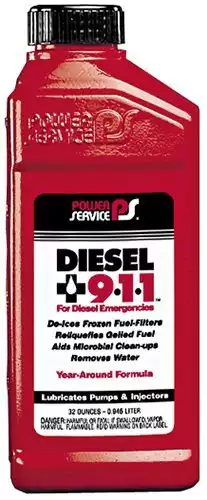One thing worse than having no fuel is having fuel but being unable to use it. That’s precisely what happens when diesel gels. Your engine will stutter and shut down, leaving you wondering what the hell is going on.
So, what you need to know is how long into storing your diesel in the cold it is likely to gel. I’ll tell you everything you need to know, as well as what diesel gelling even is, why it’s bad, and what you can do about it.
How Long Does It Take for Diesel to Gel?
The wax in your diesel won’t become solid instantly. It will start gelling gradually, and at first, the diesel might just seem murky and more viscous.
The temperature doesn’t even have to be that low for the diesel to get murky and a bit viscous — temperatures below 20°F are enough to cause that kind of reaction.
To become completely gelled, diesel needs to be at a temperature below -10°F for at least 48 hours.
You’ll know your diesel has started to gel not just because of the murkiness and the viscosity of the liquid but also because of difficulty running engines. Even if the diesel is slightly (but not completely) gelled, engines will have trouble.
Exactly What Is Diesel Gelling?
The gelling of diesel is a natural process in which paraffin wax, which is a regular part of diesel fuel, solidifies. It usually forms tiny, solid crystals in a process called crystallization.
This happens because of a sudden drop in temperature. For the wax to completely solidify, at which point we call it a gel, the temperature needs to stay below -10°F and it needs to stay like that for a long time.
However, this doesn’t apply to all fuels! The temperature at which your fuel starts to gel is called the “cloud point.” It’s called cloud point because fuel often looks cloudy and murky once it starts gelling.
Higher quality diesel fuels have lower cloud points and they’re more difficult to gel. Lower quality diesel fuels have higher cloud points, and some of them can start the gelling process at temperatures as high as 40°F.
Why Is Diesel Gelling Bad?
Gelled diesel will clog your engines — it doesn’t matter if you’re using it for a power generator or a vehicle, diesel gelling always results in clogging.
Engines clogged with diesel gel will likely stop every once in a while for seemingly no reason and often emit white smoke from the exhaust. This is a common occurrence in the winter, especially with people who drive tractors.
There’s also a possibility of long-term damage to the engine and the fuel lines because of gelling. This doesn’t happen often, though.
Gelling can occur not only while the diesel is in a container but also when it’s in a motor. So, if you leave your tractor outside during the winter, you should treat its tank with anti-gelling solutions before the temperatures drop.
How to Prevent Diesel from Gelling
First of all, if you store diesel at home, keep the containers in a storage room at an appropriate temperature. It’d be best if the temperature was above 30°F but below 70°F.
However, you should never store diesel (or any other type of fuel) in a living area because it’s a fire hazard. Instead, keep it in a shed or structure away from your house. If storing tanks indoors isn’t an option, it’d be smart to bury them in the ground, which acts as natural insulation.
When it comes to your vehicles, there are anti-gel solutions that you can add to your tanks when the temperatures fall below 30°F. Anti-gel additives are designed to prevent diesel from starting to gel even at temperatures below 10°F. However, it’s impossible to guarantee functionality below that temperature.
The smartest thing you can do, aside from adding anti-gel additives, is park your vehicles and equipment in an enclosed, preferably insulated area. Garages are obviously ideal, but mechanization sheds (even without insulation) are also good.
Covering the vehicle with a tarp is another step in the right direction.
How to Restore Gelled Diesel
So, the diesel in your vehicle gelled and you don’t know what to do? Not to worry.
Diesel 911 is probably the best solution. This product reliquefies gelled diesel fuel, allowing you to get back on the road again.
Another option is just heating up your vehicle. Cover your vehicle in a tarp and turn an electric heater on. The tarp will prevent the heat from dissipating, and the diesel will reliquefy in a few hours.
Make sure you watch over the electric heater, however, because you don’t want the tarp to catch fire!
Finally, you can add fuel warmers to your vehicle. Fuel warmers are a bit of an investment, but if you need to regularly use your vehicle through harsh winters, it’s the best way to keep the diesel liquid!
These devices are normally only needed for very big vehicles, such as 18-wheelers, that operate in very cold areas, which makes them a good fit for working vehicles, such as bulldozers and tractors.










